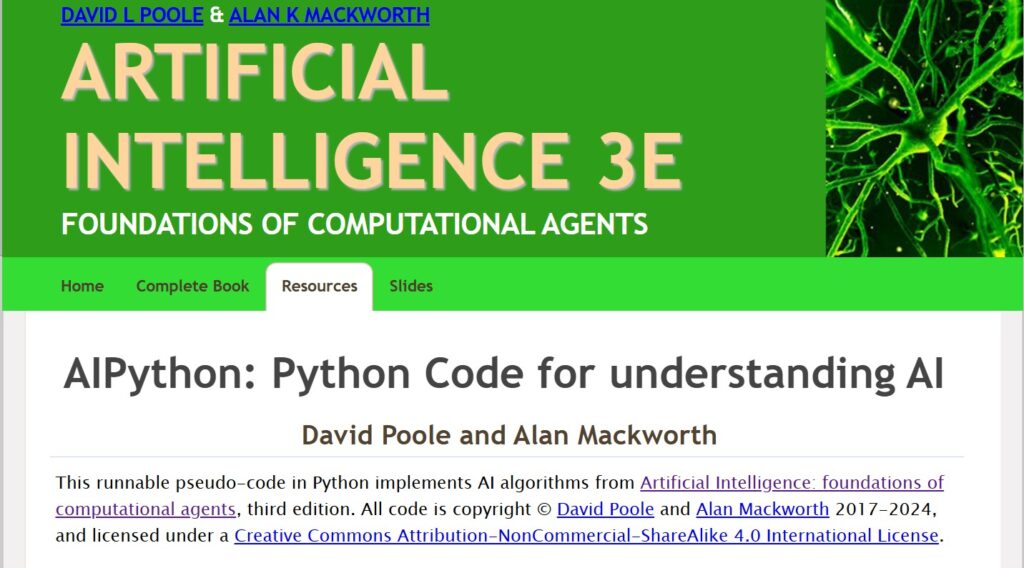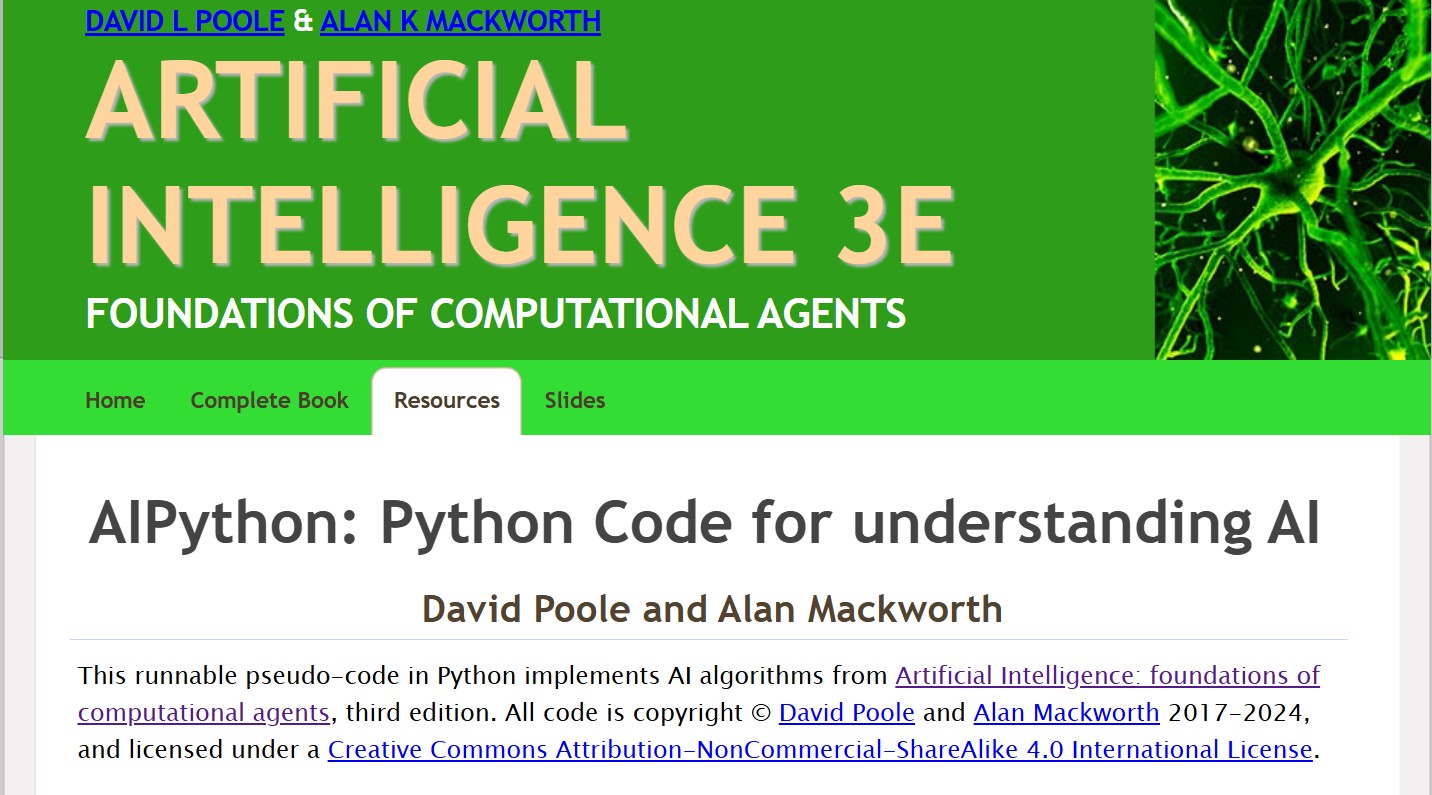Artificial Intelligence (AI) is no longer just an abstract concept studied in research labs- it’s shaping industries, driving innovation and transforming the way humans interact with technology. To build truly intelligent systems, however, learners need both a solid theoretical foundation and practical hands-on tools.

That’s where Artificial Intelligence: Foundations of Computational Agents (3rd Edition) by David L. Poole and Alan K. Mackworth stands out. Published by Cambridge University Press in 2023, this book is widely recognized as a comprehensive guide to modern AI. More importantly, it comes with AIPython, runnable Python code that lets readers experiment with algorithms in real-time, bridging the gap between theory and practice.
Table of Contents
This blog provides a chapter-wise guide to the online learning resources that complement the book. Whether you are a student, researcher, or professional exploring AI systems, this roadmap will help you connect theory with implementation.
Chapter 1: Artificial Intelligence and Agents
- Introduces the foundations of AI and intelligent agents.
- Online resource: AAAI AI Topics – a curated collection of introductory materials on AI concepts, history and applications.
Chapter 2: Agent Architectures and Hierarchical Control
- Covers how agents interact with environments and introduces hierarchical control.
- AIPython implementations:
agents.py: simple agent controller.TP_env.pyandTP_agent.py: define the environment and agent (Examples 2.1, 2.2).agentEnv.py,agentMiddle.py,agentTop.py: hierarchical agent (Examples 2.4–2.6).
Chapter 3: Searching for Solutions
- Focuses on search algorithms like depth-first, A* and branch-and-bound.
- AIPython implementations:
searchProblem.py: defines search problems and graphs (e.g., Figures 3.3, 3.7, 3.10).searchGeneric.py: generic search (DFS, A*).searchMPP.py: A* with multiple path pruning.searchBranchAndBound.py: branch-and-bound search.
Chapter 4: Reasoning with Constraints
- Introduces constraint satisfaction problems (CSPs).
- AIPython implementations:
cspProblem.py: defines CSPs.cspExamples.py: example problems (crosswords, map coloring).cspDFS.py: depth-first CSP search.cspSearch.py: integrates Chapter 3 search methods with CSPs.cspConsistency.py: domain splitting, arc consistency.cspSLS.py: stochastic local search.cspSoft.py: soft constraints with branch-and-bound.
Chapter 5: Propositions and Inference
- Explores propositional logic, definite clauses and inference mechanisms.
- AIPython implementations:
logicProblem.py: defines logic problems.logicBottomUp.py: bottom-up inference.logicTopDown.py: top-down inference with user queries.logicExplain.py: knowledge-based debugging.logicAssumables.py: assumables and diagnosis.logicNegation.py: negation-as-failure.
- Prolog examples: electrical circuits (
elect_prop.pl), defaults (elect_naf.pl), and beach domain (beach.pl).
Chapter 6: Deterministic Planning
- Discusses planning with STRIPS and related algorithms.
- AIPython implementations:
stripsProblem.py: defines STRIPS representations and block-world problems.stripsForwardPlanner.py: forward planning.stripsRegressionPlanner.py: regression planning.stripsHeuristics.py: heuristics for planning.stripsCSPPlanner.py: planning as a CSP.stripsPOP.py: partial-order planning.
Chapter 7: Supervised Machine Learning
- Covers core ML methods: decision trees, regression, boosting.
- AIPython implementations:
learnProblem.py: ML infrastructure.learnNoInputs.py: trivial learning baseline.learnDT.py: decision tree learning.learnCrossValidation.py: cross-validation methods.learnLinear.py: linear & logistic regression with SGD.learnBoosting.py: gradient-boosted trees.
Chapter 8: Neural Networks and Deep Learning
- Introduces feedforward neural networks, optimization, dropout.
- AIPython implementations:
learnNN.py: neural networks with SGD, momentum, RMSProp (Adam as exercise).keras_mnist.py: Keras code for MNIST (Figure 8.5).
- Further resources:
- Annotated history of deep learning (Jürgen Schmidhuber).
- Updates on large models (Nemotron-4-340B, Llama 3.1).
Chapter 9: Reasoning with Uncertainty
- Covers Bayesian reasoning, belief networks, HMMs.
- AIPython implementations:
probVariables.py,probFactors.py: random variables, factors.probGraphicalModels.py: graphical models.probRC.py: recursive conditioning.probVE.py: variable elimination.probStochSim.py: stochastic simulation methods (likelihood weighting, Gibbs sampling, etc.).probHMM.py: hidden Markov models.probLocalization.py: localization example.probDBN.py: dynamic belief networks.
Chapter 10: Learning with Uncertainty
- Focus on clustering and probabilistic learning.
- AIPython implementations:
learnKMeans.py: k-means clustering.learnEM.py: expectation maximization (EM).
Chapter 11: Causality
- Introduces causal reasoning, do-operator, counterfactuals.
- AIPython implementations:
probDo.py: interventions with do-operator.probCounterfactual.py: counterfactual reasoning.
Chapter 12: Planning with Uncertainty
- Covers decision networks and MDPs.
- AIPython implementations:
decnNetworks.py: decision networks with search & variable elimination.mdpProblem.py: MDPs with value iteration.mdpExamples.py: example MDPs.
Chapter 13: Reinforcement Learning
- Explains Q-learning, replay, model-based RL, feature-based RL.
- AIPython implementations:
rlProblem.py: RL problem setup.rlExamples.py: RL domains.rlQLearner.py: Q-learning.rlQExperienceReplay.py: Q-learning with replay.rlModelLearner.py: model-based RL.rlFeatures.py: feature-based learner + monster game features.
Chapter 14: Multiagent Systems
- Discusses game theory, minimax, multiagent RL.
- AIPython implementations:
masProblem.py: two-player zero-sum games.masMiniMax.py: minimax with alpha-beta pruning.masLearn.py: multiagent reinforcement learning.
Chapter 15: Individuals and Relations
- Focus on Prolog-based relational reasoning.
- Prolog resources:
elect_reln.pl: electrical wiring.geography_DB.pl: South America geography DB.geography_CFG.pl: English grammar rules.geography_QA.pl: question answering.geography_QA_query.pl: query building.
Chapter 16: Knowledge Graphs and Ontologies
- Introduces Wikidata, RDF, Schema.org.
- Resources:
- Wikidata example: Christine Sinclair (Examples 16.6, 16.7).
- Prolog code:
sem_web.pl,sem_web_scheme.pl.
Chapter 17: Relational Learning and Probabilistic Reasoning
- Covers collaborative filtering & relational probabilistic models.
- AIPython implementations:
relnCollFilt.py: collaborative filtering.relnProbModels.py: relational probabilistic models → standard belief networks.
Chapter 18: The Social Impact of AI
- Discusses AI governance, ethics, automation, safety, and employment.
- Key readings:
- AI harms vs existential risk (Scientific American).
- Technology and work (AEA, OECD).
- UN AI Advisory Board reports.
- AI and democracy indexes.
- AI for Africa case studies.
Chapter 19: Retrospect and Prospect
- Reflects on past predictions and future AI directions.
- Key readings:
- Pew Research: AI’s best/worst impacts by 2035.
- Rodney Brooks’ retrospective predictions.
- AI in finance case study.
- Scientific discovery with AI.
- Towards trustworthy hybrid AI systems.
Download for Free:
Download and explore here: https://aipython.org
Link for Code : https://artint.info/AIPython/aipython.zip
Link to download complete pdf: https://artint.info/AIPython/aipython/aipython.pdf
Conclusion
Artificial Intelligence: Foundations of Computational Agents is more than a textbook—it’s a complete learning ecosystem. By combining rigorous explanations with AIPython implementations, it empowers readers to go beyond memorizing concepts and instead experiment, test, and build real AI systems.
From foundational topics like search and logic to advanced areas such as deep learning, reinforcement learning, causality, and the societal impact of AI, the book ensures a holistic understanding. With freely available online resources and runnable Python code, learners gain both clarity of concepts and confidence in application.
If you’re serious about mastering AI, this book (and its companion AIPython resources) is a must-read—whether for academic study, self-learning, or applying agent-based reasoning in real-world systems.
Related Reads
- Agentic Design Patterns – A Hands-On Guide to Building Intelligent Systems by Google’s Antonio Gulli
- ART: Agent Reinforcement Trainer – Simplifying Reinforcement Learning for LLMs
- PySpark Cheatsheet: The Ultimate Quick Reference for Big Data & Machine Learning
- Mastering the Maximum Average Subarray I Problem in Python – LeetCode 75 Explained
- Mastering the Maximum Number of Vowels in a Substring Problem in Python – LeetCode 75 Explained


2 thoughts on “AIPython & Online Learning Resources for Artificial Intelligence: Foundations of Computational Agents (3rd Edition)”